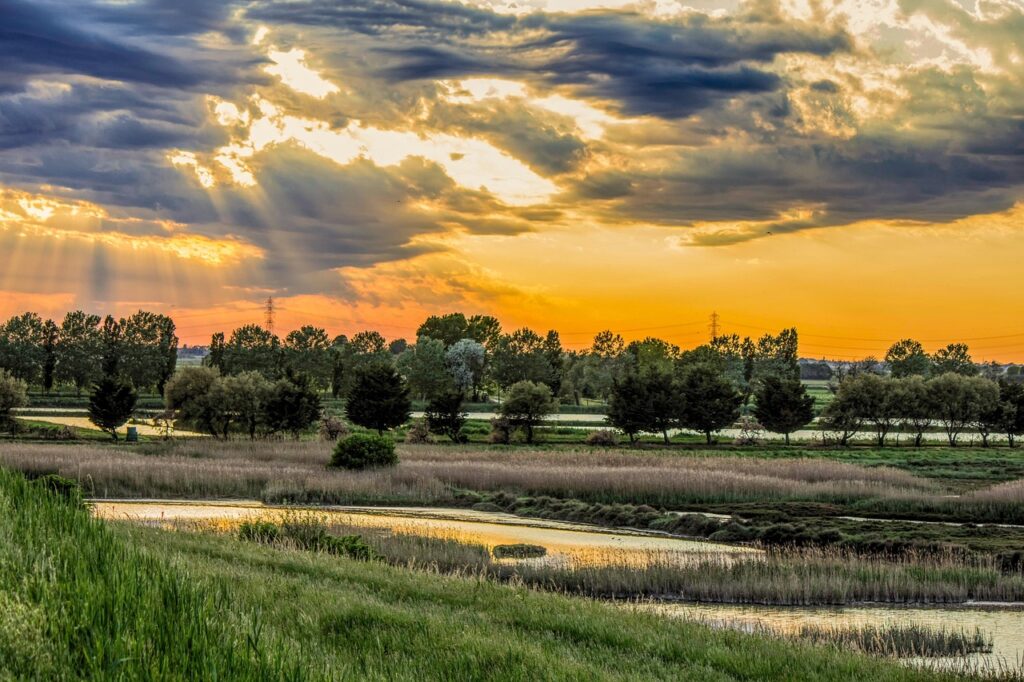CNR, OGS, and CORILA are the institutions responsible for governing the Po Delta and Northern Adriatic Lagoons Supersite, a key area for understanding the dynamics between rivers and the sea.
Transitional environments, such as rivers, estuaries, deltas, lagoons, and coasts, represent the point of contact between land and sea. These “hybrid” areas are home to a concentration of highly important ecosystem services: from food production to water supply and transportation. However, they are also complex and fragile ecosystems, increasingly threatened by climate change and human activities. Urbanization, intensive agriculture, energy exploitation, and pollution are profoundly transforming river-sea systems, accelerating biodiversity loss and increasing the risk of extreme events. For this reason, researchers, institutions, and political actors are called upon to develop new adaptation and governance strategies to ensure the health of transitional environments and the future of the communities that depend on them. Transitional environments—rivers, estuaries, deltas, lagoons, and coasts—represent the point of contact between land and sea. These areas are home to essential ecosystem services: from natural water purification and biodiversity maintenance to flood and coastal erosion protection, as well as recreational and cultural values linked to the landscape. At the same time, these are complex and fragile ecosystems, increasingly threatened by climate change and anthropogenic pressures. Urbanization, intensive agriculture, energy exploitation, and pollution are profoundly transforming river-sea systems, accelerating biodiversity loss and increasing the risk of extreme events. Faced with these challenges, researchers, institutions, and policymakers are called upon to develop new adaptation and governance strategies to ensure the health of transitional environments and the future of the communities that depend on them.
This is the context for DANUBIUS-ERIC, the large pan-European distributed research infrastructure (RI), built on existing expertise to support interdisciplinary research on river-sea systems (RSSs), from environmental to social and economic sciences. With ten SuperSites distributed across several European countries, DANUBIUS-ERIC provides in situ and remote observations, laboratories, modeling tools, and knowledge exchange platforms to understand and sustainably manage the dynamics of interaction between freshwater and marine waters.
The main objectives of the infrastructure are to foster scientific excellence along the river-sea continuum, promote multidisciplinary dialogue between scientific communities, and provide integrated knowledge to support environmental protection and sustainable development policies.
Among the ten Super Sites, a prominent role is played by the Italian site of the “Po Delta and Northern Adriatic Lagoons” (Venice Lagoon and Marano-Grado Lagoon), chosen for the extraordinary richness of its natural environments and the variety of bio-geophysical, ecological, and socio-economic processes that intertwine there. It is a unique territory where rivers, lagoons, and the sea coexist in a dynamic balance that generates high biodiversity, sites of great cultural value, and important human activities. The Supersite is a veritable living laboratory dedicated to coastal transition environments, where scientific research collaborates with local communities to enhance natural resources, improve resilience, and promote sustainable development models.
The governance of the Italian Supersite is based on a truly collaborative and integrated approach and is entrusted to three national reference institutions:
- The National Research Council (CNR) – through the Institute of Marine Sciences (CNR-ISMAR) – is the leader of the DANUBIUS-ERIC Modeling Node, one of the infrastructure’s four thematic nodes, and coordinates scientific activities at the Italian level, providing advanced modeling tools, including the SHYFEM model, as well as data and research products in the Supersite area;
- The National Institute of Oceanography and Experimental Geophysics (OGS) is directly involved in the Modeling Node and in data observation, analysis, and integration activities, contributing with expertise in biogeochemical and operational modeling to provide high-resolution forecasts for the northern Adriatic and the Mediterranean;
- The Consortium for the Coordination of Research on the Venice Lagoon System (CORILA) is the Supersite’s point of contact and coordinates activities involving stakeholders and local institutions, promoting synergy between research, governance, and civil society and ensuring the Supersite’s connection with the international components of DANUBIUS-ERIC.
The Po Delta and Northern Adriatic Lagoons Supersite also stands out for the strong involvement of the scientific community and local stakeholders. Ministries, regional environmental agencies, local authorities, universities, trade associations, NGOs, and citizens are actively involved in a co-design process that aims to integrate local needs with the solutions offered by scientific research. From this perspective, the Supersite is not only an infrastructure at the service of science, but also a meeting point between research, governance, and society, capable of generating knowledge and innovation. questa prospettiva, il Supersito non è soltanto un’infrastruttura al servizio della scienza, ma un punto d’incontro tra ricerca, governance e società, capace di generare conoscenza e innovazione.
Publication link
https://doi.org/10.1016/j.ecss.2025.109453
Photo
Po River. Credits: chatst2 by Pixabay.


